贝恩:(英文52 页)
- In some countries, customer loyalty as measured by NPS improved in 2013 from the year earlier, as the financial crisis recedes and some banks have devoted more effort to addressing customers’ priorities. The continued surge in mobile banking no doubt contributed to higher scores, because mobile tools have a strong, positive effect on customer advocacy.
- NPS varies by country and is generally higher in developing countries. But what matters most to an individual bank is how it performs relative to its peer group.
- Within national markets, NPS varies widely from bank to bank. In Australia, for instance, top-performer Bendigo has an NPS 45 points higher than the worst performer and 32 points above the country average.
- For the first time in a US region, a national bank leads the traditional banks in NPS, with Chase out front in the South. In 2011, Chase started a deliberate effort to become more customer-centered rather than product-centered, and that shift has paid off with gains in loyalty, new relationships and share of wallet.
- Wealthier customers have a high economic value when banks earn their advocacy. Banks in developing markets, like China and India, generally do better in targeting and serving affluent customers, which is reflected in their NPS scores from the affluent. Banks in Canada, the US, the UK, Australia and France still struggle in this regard.
- Direct banks such as ING and First Direct have been the NPS leaders in many countries for several years. They often target self-directed, digital-savvy customers with a simple proposition around low cost, high rates and fast processes.










- Banks everywhere are expanding digital channels, but the pace of engagement varies dramatically. The Nordic countries lead in the share of digital banking interactions, while a number of Asian countries lag.
- Generational differences in digital usage persist. For example, some 18% of US customers under age 35 opened an account online, twice as many as customers over age 55.
- Countries vary in the pace of their evolution to deploy each type of channel to advantage. Some countries, particularly the Nordic countries, have made significant progress in steering routine transactions out of the branch and into lower-cost, self-service digital channels, including smart ATMs.
- Within most countries, individual banks vary widely in their progress to move the routine to digital channels and refocus the branch on sales and high-value service. In Spain, for instance, Bankinter leads the least digital bank by 25 percentage points.
- When it comes to account opening, direct banks excel in handling the task online. Yet among other banks, account opening still occurs mostly in the branch, though that’s shifting to the phone in the UK, Germany and the Netherlands.
- Experiments with branch features and layout abound. Raiffeisen’s flagship branch in Zurich offers advanced technologies such as a robotic retrieval system for round-the-clock access to safety deposit boxes. Other banks have launched branches that resemble lounges or cafes, either to complement a strong direct bank presence or to encourage high-value relationships.
- ATMs play an outsize role in Japan, Indonesia, Russia and Singapore. In a few places like Singapore, more versatile ATMs make customers’ lives easier by allowing them to buy airline tickets or pay parking fines






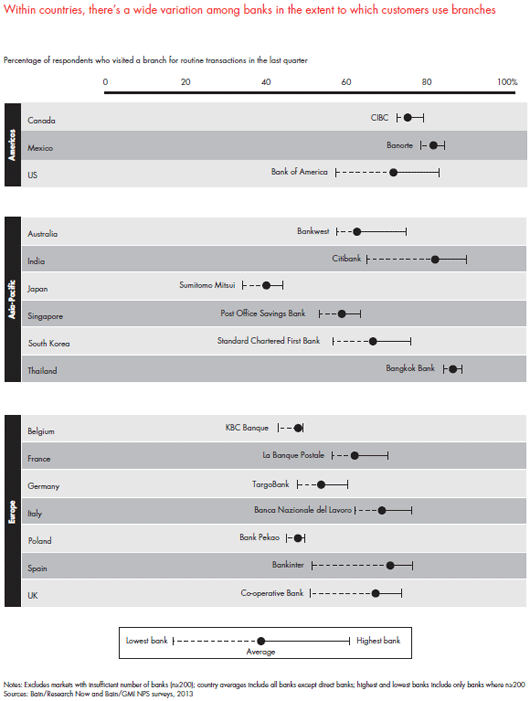

- Across the globe, mobile banking continues to spread. Customers have embraced banking on their smartphones and tablets when banks offer applications that are both useful and easy to navigate.
- Commonwealth Bank of Australia, for example, offers a versatile mobile platform that allows customers to trade stocks, pay third parties using their mobile number or email, and explore visual and written details of homes for sale.
- China, Chile, South Korea and India have leapfrogged other countries that lag in mobility, like Belgium, Japan and Canada. In general, the developing countries have forged further ahead, and several have more than half of their respondents using mobile channels. They show an especially big lead in mobile payments, with almost twice the level of activity as developed countries.
- Within a given country, however, there’s a wide dispersion in mobile uptake. And not all of the mobile leaders are direct banks. Citibank in India has a higher mobile penetration than Comdirect in Germany and Fineco in Italy. In the US, Chase leads among traditional banks. It invested heavily in mobile technology such as smartphone payments, and its recent advertising highlights how the technology simplifies people’s lives.
- Regardless of bank model, frequent mobile users consistently report higher NPS than non-users. The greatest gap in NPS between the two groups occurs in China, Japan and Thailand, while the narrowest gap is found in Belgium, France and the Netherlands.
- Mobile banking has risen among all age groups and income levels. But younger customers rank as the most avid users, especially in Australia, the US, India and Sweden.










- New banking relationships—people either new to banking or switching their primary relationships from another bank—are hard to come by. Only 0.7% of respondents were new to banking in the developed world, with another 2.5% switching from their primary bank.
- Still, winning an outsize proportion of primary relationships, anchored on the basic checking or current account, remains an important goal because of the annuity value of cross-selling other products. Our survey finds that respondents hold roughly three other products with their primary bank besides the basic account.
- A bank’s current NPS strongly predicts its success in winning these new relationships. NPS explains about half of the variance among banks in relative win rate (a bank’s win of switchers plus first-time joiners, relative to its share of primary customers).
- New customers can be won in many ways. ING in Spain does it largely by developing strong product packages, targeted to particular segments such as university students.
- Besides loyalty, what it takes to win new relationships differs by country. Respondents who chose a new bank most commonly cited fees, ease of account opening and branch locations as the reasons. Interest rates also were a major factor in several markets, including the UK, Sweden and Singapore. And ATM locations ranked high in Argentina, Hong Kong, Indonesia and Japan.
- Preventing attrition arguably outweighs winning new relationships, given the slow rate of new account formation. In the US, banks could have headed off most of the switching, because three-fifths of customers cited factors such as high fees and poor service. Less than one-fifth of switching resulted from customers taking better offers from other banks.












- A surprisingly large opportunity exists to sell new products such as credit cards to existing customers. In the developing countries, 83% of respondents purchased a new product over the past year; in the developed countries, 50% did.
- While the primary bank captures most of these new products, on average, 35% of new product sales go to a competitor. The competitors’ share ranges from 19% in Denmark, which has a very concentrated banking sector, to a remarkable 60% in the UK and 54% in Germany, where the global trend to unbundle product holding has gone further. The UK and German markets have many specialized challenger banks, as well as customers who have a low regard for large banks after the crisis and, in Germany, who are highly price sensitive.
- Cross-selling performance varies even more by bank within countries. In Canada, for instance, RBC has a win rate of more than two times the least effective bank, and Santander has a similar lead in the UK.
- While many factors account for this difference in performance, customer loyalty has a big influence on a bank’s current cross-selling performance and its future potential. Customers who are promoters of their primary bank buy more from that bank than detractors do. In developing countries, the NPS gap between the two groups of customers amounts to 9 percentage points; in developed countries, the difference is 14 points.
- Consider banking products in China. Some 61% of promoters have bought an auto loan from their primary bank, vs. just 31% of detractors. The spread is similar for life insurance and wealth and investment products.
- The higher cross-sell rates that result from stronger loyalty lead to broader product holdings with the primary bank as well. Promoters hold on average 68% of products with their primary bank vs. 60% for detractors.












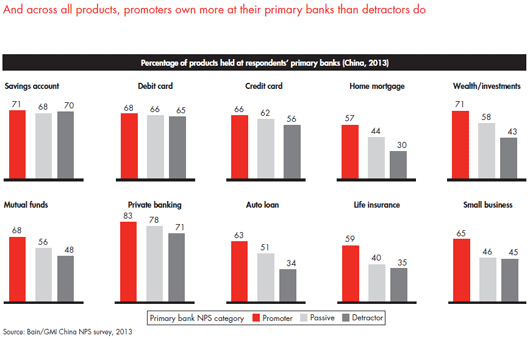

- Winning new customers, limiting attrition and seizing the cross-sell opportunity all start with a bank’s ability to earn loyalty. But the experiences of leading banks show that five other elements are required in order to generate outsize growth.
- These start with insightful and practical customer segmentation schemes. In the US, younger customers place far more importance on recommendations from others and on mobile tools than older customers, who care relatively more about branch location and helpful staff.
- Banks must also ensure that they have a competitive suite of products. In the US, no traditional bank ranked highest on more than one product, so they clearly have room to improve.
- Selling capabilities are critical. In the US, roughly one-third of products get sold, not bought. The leading bank performs two to five times better than the laggard, depending on the product category.
- Service stands as the dominant cause of loyalty in most markets. To delight customers these days, the banking experience must be consistent and seamless in person, online, on mobile and on the phone, because customers increasingly hop among channels to complete a task.
- Finally, these four capabilities should reinforce and be supported by the bank’s brand and reputation. USAA has one of the strongest brands in banking despite its modest investment in advertising, in part because it serves such a specific, homogeneous group of customers—the military, veterans and their families—and consistently delivers on the brand promise.
- In general, loyalty leaders outperform on both win rates for new relationships and cross-selling to existing customers. Banks that have advanced on several of the five elements thus have started to translate loyalty to better economics.














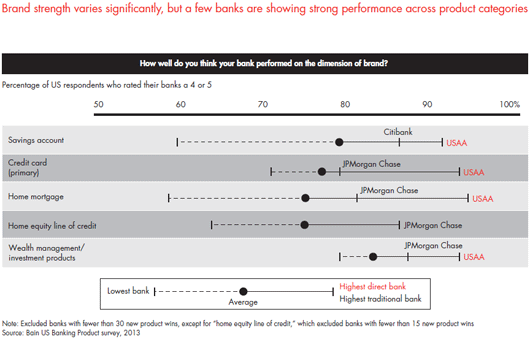

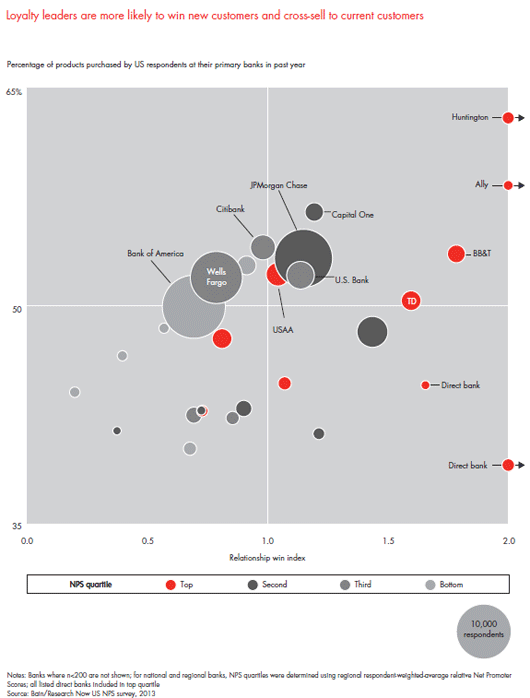



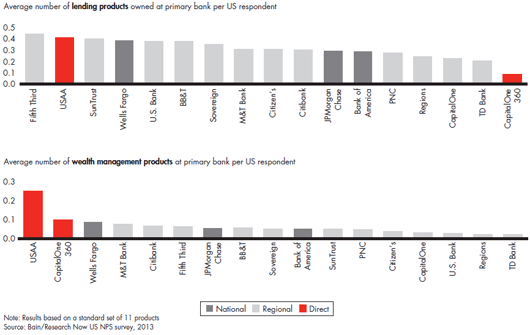

- On a scale of zero to 10, where zero represents “not at all likely” and 10 represents “extremely likely,” how likely are you to recommend your primary bank to a friend or relative?
- Tell us why you gave your primary bank the score you did.
- How long have you used this bank as your primary bank?
×
![]()
下载《贝恩:(英文52 页)》需 22点,包月包季包年会员(点此注册)免费下载。
一、非注册用户快速自助下载两步完成:1 注册(点此),2 购点卡(点此) 充值(点此)自主下载
二、非注册用户直接付款( 点此付款),付款后短信(18121118831或加微信)告知 题目或者Email,我们通过邮件发给您。 需要帮助?
一、非注册用户快速自助下载两步完成:1 注册(点此),2 购点卡(点此) 充值(点此)自主下载
二、非注册用户直接付款( 点此付款),付款后短信(18121118831或加微信)告知 题目或者Email,我们通过邮件发给您。 需要帮助?
专题跟踪研究报告
企业出海
新质生产力
低空经济
生成式AI
工业互联网
数字藏品
动力电池
ESG
数字化转型
机械零部件
氢能
碳中和
区块链
元宇宙
建筑
矿产
安永
数字货币
新基建
日化
案例分析
毕马威
贝恩咨询
普华永道
波士顿
罗兰贝格
德勤咨询
埃森哲
麦肯锡
电商
金融科技
人工智能
物联网
互联网金融
大数据
3D打印
食品饮料
家电行业
零售连锁
新能源
商业地产
快递行业
机械设备
汽车
核电
电子产业
电力行业
新兴产业
纺织服装
医药生物
广告传媒
金融投资
航空
旅游
酒业
能源
有色金属
通信
石油化工
物流供应链
房地产
可行性报告
PPP
商业计划书
五力分析
并购重组
发展战略
SWOT
产业链
钻石模型
价值链
PEST
人力资源
面板模型
stata
精华推荐
供应链金融
互联网+
机器人
O2O
教育培训
论文资料查找
写作修改服务
EMBA论文写作
硕士论文
本科论文
论文写作

